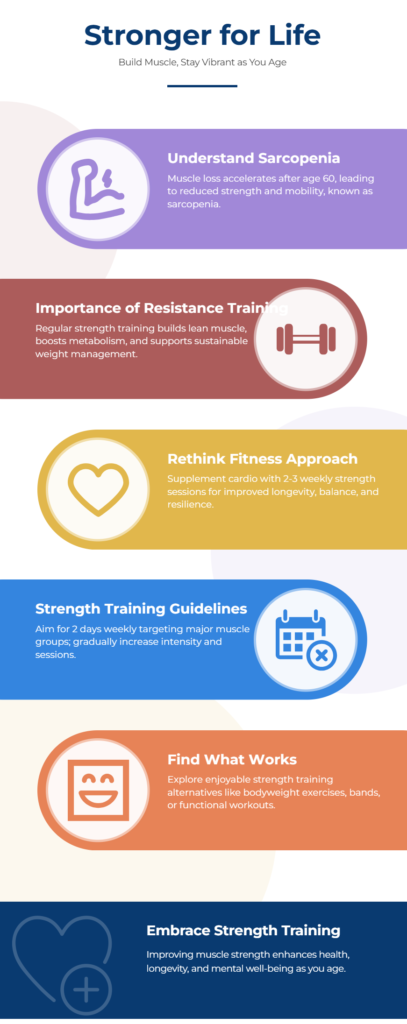Don’t miss a post. Click here to sign up for our free newsletter.
Estimated reading time: 5 minutes
Stronger for Life
Staying active as we age is one of the best ways to ensure a long, healthy, and fulfilling life. However, when it comes to exercise, many people have historically focused more on cardio while overlooking one key factor: strength training.
Building and preserving muscle should be at the top of your priority list if you want to maintain independence, keep doing the activities you love, and support sustainable weight management.
Why Strength Training Matters as You Age
Muscle loss is a natural part of aging. After the age of 30, adults lose approximately 3% to 8% of their muscle mass per decade, and this rate accelerates after 60. This decline, known as sarcopenia, leads to reduced strength, balance issues, and a higher risk of falls and injuries. A 2019 study published in The Journal of Strength and Conditioning Research found that muscle loss significantly affects functional movement, making everyday tasks like climbing stairs, carrying groceries, or even getting up from a chair more difficult over time.
The good news? Strength training can slow down or even reverse this process. Regular resistance training helps maintain and build lean muscle, which not only supports mobility and physical function but also boosts metabolism. Muscle burns more calories than fat, meaning that increasing lean muscle mass naturally raises your Basal Metabolic Rate (BMR)—the number of calories your body burns at rest. This makes strength training a powerful tool for sustainable weight management.
Rethinking the Cardio-Only Mindset
For decades, fitness recommendations leaned heavily on cardiovascular exercise. While cardio is essential for heart health, it’s only part of the equation. Strength training was often overlooked, especially for older adults, due to misconceptions that it was either unnecessary or too intense. However, research consistently shows that adding resistance training to your routine leads to stronger bones, better balance, and greater overall resilience.
A 2022 study in Sports Medicine revealed that just two to three sessions of strength training per week can reduce the risk of injury, improve mental well-being, and enhance overall longevity. And contrary to popular belief, strength training doesn’t necessarily mean heavy weightlifting—it can be adapted to suit all fitness levels and preferences.
How Much Strength Training Do You Need?
The American College of Sports Medicine (ACSM) and the Centers for Disease Control and Prevention (CDC) both recommend at least two days per week of strength training for adults. Ideally, each session should include exercises targeting major muscle groups, including the legs, core, back, chest, arms, and shoulders. Here’s a breakdown of what research suggests for optimal strength training benefits:
- Beginners: Start with 2 sessions per week, using bodyweight exercises or resistance bands to build a foundation.
- Intermediate: Progress to 2-3 sessions per week with added resistance like dumbbells, kettlebells, or TRX bands.
- Advanced: Aim for 3-4 sessions per week, incorporating varied techniques such as progressive overload, circuit training, or heavier resistance.
Each workout should include 8 to 12 repetitions per exercise, with 2 to 3 sets to effectively build strength.
Strength Training That Works for You
Not everyone enjoys traditional weightlifting, and that’s okay! The key to long-term success is finding a workout you genuinely enjoy. Strength training can take many forms, and there’s no one-size-fits-all approach. Here are some engaging alternatives:
- Bodyweight Exercises: Push-ups, squats, lunges, and planks are fantastic for building strength without needing equipment.
- TRX Bands: These suspension trainers use your body weight and gravity for resistance, making them ideal for all fitness levels. Check out https://amzn.to/412KQjd.
- Resistance Bands: Lightweight and portable, resistance bands provide an effective full-body workout without the intimidation of heavyweights.
- Functional Strength Workouts: Activities like rock climbing, hiking with a weighted pack, or yoga with strength-focused poses all build muscle in a practical way.
- Weight Machines or Free Weights: Incorporating machines or free weights can provide targeted muscle engagement if you enjoy structured gym workouts.
Strength Training for Longevity and Well-Being
Beyond physical health, strength training has profound effects on mental well-being. Research from Harvard Medical School found that resistance training can reduce symptoms of anxiety and depression, increase self-confidence, and enhance cognitive function. Additionally, maintaining strength supports independence, allowing people to remain active and self-sufficient well into older age.
Join the Conversation
Have you incorporated strength training into your routine? What’s worked best for you? Have you faced any challenges or breakthroughs? Let’s discuss in the comments below!
Strength training isn’t just about building muscle—it’s about building a foundation for a healthier, more active, and independent future. If you’re new to it, start small, stay consistent, and find an approach that excites you. The benefits go far beyond aesthetics; they shape the way we move, feel, and experience life as we age.
👉 Start today!
Check out The Seven Pillars of Sustainable Health and Wellness, an introduction to our overall wellness coaching strategy.
Subscribe to our free newsletter to receive more health tips right in your inbox, or schedule a free 30-minute 1:1 call for a personal consultation.
Stronger for Life | Cheat Sheet

